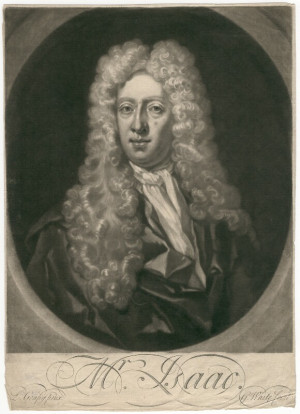Annotation:Mr. Isaac’s Maggot
X: 1 T:Mr. Isaac's Maggot. (p)1695.PLFD1.325 M:3/2 L:1/8 Q:3/4=90 B:Playford, Dancing Master,9th Ed,1695. R:.Maggot O:England;London H:1695. Z:Chris Partington <www.cpartington.plus> K:C V:1 clef=treble name="1." [V:1] g4e4d4|cde2d2c2d2G2|G2c4B2A4|A2d4A2B2G2| g4e4d4|cde2d2c2d2G2|G2c4B2 A2fe|d2c2d2B2c4:| |:E2G4A2G4|E2G4ABc2G2|E2G4A2G4|E2G4ABc2G2| (g3f/g/)(a3g/f/)(g3f/g/)|agfe fedcd2G2|(g3f/g/)(a3g/f/)(g3 f/g/)|\ agfe defgd2c2| e4(f3e/f/)g4|cde2d2c2d2G2|e4(f3 e/f/)g4|G2c2cde2d2c2:|

Dance researcher Moira Goff has discovered that "Mr. Isaac" was in fact a Royal dancing master named Francis Thorpe, offering as proof the will of his uncle, Jerome Gahory, who previously occupied the post of Royal dancing master. Gahory left the residue of his English estate to "Francis Thorpe his nephew (known by the name of Isaac)." Francis was the product of Gahory's sister and "Mnsr. Isac", who had a reputation as one of the best dancing masters in Paris. Young Francis may have taken the name Isaac "as a compliment to his father as well as to show his lineage with its associated status." After some time dancing in France, the younger "Mr. Isaac" removed to England, and is recorded as having danced in the English court masque Calisto in 1675. This Mr. Isaac died in 1681, and Goff concludes that references to "Mr. Isaac" after this must refer to his son. John Essex, in his Preface to The Dancing Master (1728) recorded:
The late Mr. Isaac, who had the Honour to teach and instruct our late most excellent and gracious Queen when a young Princess, first gained the Character and afterwards supported that Reputation of being the prime Master in England for forty Years together: He taught the first Quality with Success and Applause, and was justly stiled the Court Dancing-Master, therefore might truly deserve to be called the Gentleman Dancing-Master. (p. xi)[1]
Sixteenth and seventeenth century country dance tunes sometimes had the word "maggot" in their titles, perhaps derived from Italian Maggiolatta or Italian May song, but used in England to mean a whim, fancy, plaything, 'trifle'--essentially an 'earworm'[2]. A maggot was also another name for a dram, a small unit of liquid measure. This anonymous melody dates to 1695, when it first appeared in Playford's Dancing Master, 9th edition. The dance and tune were retained in the long running series through the 18th and last volume, then published by John Young, heir to the Playford publishing concern. It also was included by the Walsh's (father and son) in their Compleat Country Dancing Master, editions of 1718, 1735 and 1754. For more on Isaac see Jennifer Thorp's article "Mr. Isaac, Dancing-Master" in Dance Research - Volume 24, Number 2, Winter 2006, pp. 117-137, where, for example, she gives:
The earliest references to him as a performer in London connect him with the Stuart Court, for in April 1673 a dancer named Isaac was one of several dancers (along with Mr. Priest) who performed as Venetians, a Spaniard, a Conjuror, Devils, and Shepherds, in a masquerade for King Charles II's illegitimate son, the Duke of Monmouth.
A version of "Mr. Isaac's Maggot" has been found included the Suite in C Major[3] by English court composer and recorder player James Paisible (1656-1721) as an "Ornepaipe"
- ↑ This quote and information above on Francis Thorpe accessed on 08.07.2020 from Moira Goff's blog "England's Royal Dancing Masters 1660-1714", danceinhistory.com [2]
- ↑ Emmerson (1972) states that maggot derives from the Italian maggioletta, which he translates as a 'plaything', but what his source is for this translation is unknown.
- ↑ A recording of Plaisible's suite has been issued as Arcana Recordings A527, "The Queen's Favourites: Music for Oboe Band at the Court of Anne Stuart", performed by La Petite Ecurie. We are indebted to David Schonfeld for information on this connection.


